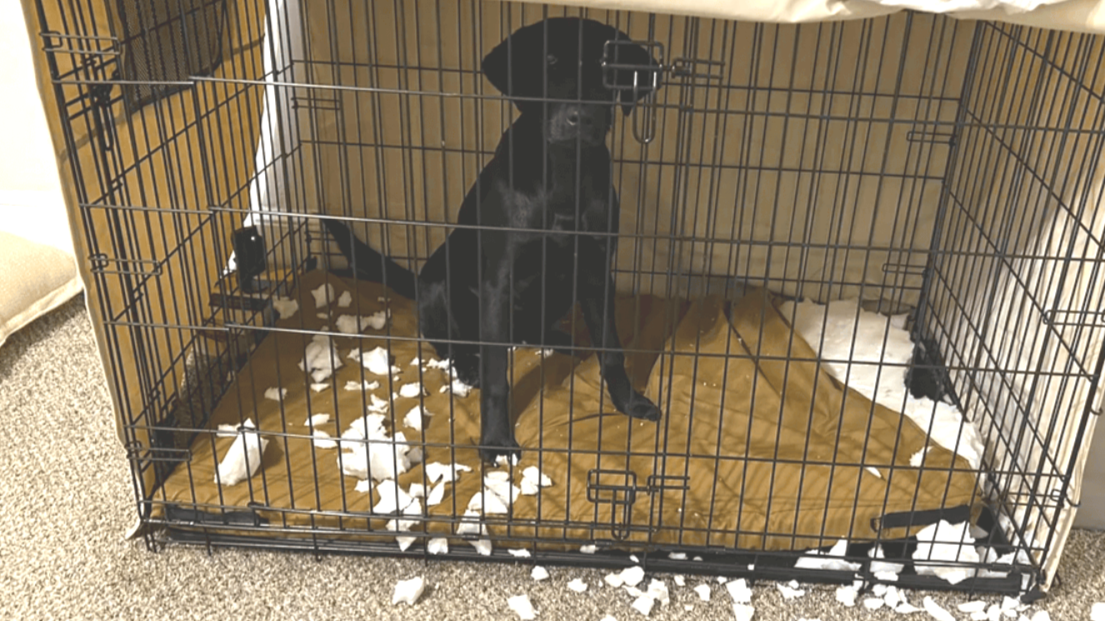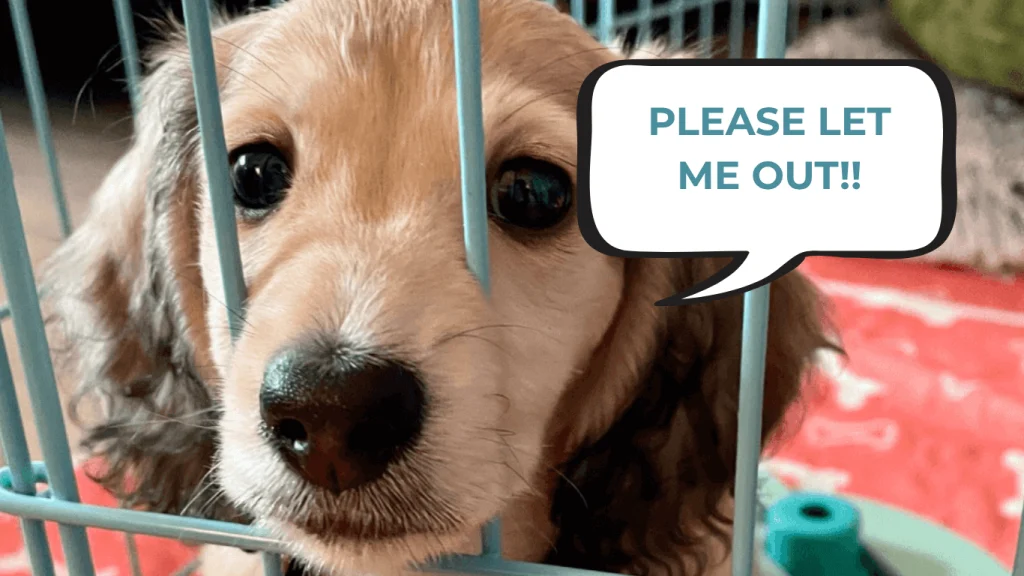Is your dog crying nonstop in their crate? It can be frustrating and heartbreaking to hear those whines and barks, especially when you don’t know how to help.
You want your furry friend to feel safe and calm, but the crying keeps going. The good news is, you can change this. You’ll discover simple, proven steps to stop your dog from crying in the crate. By understanding what’s behind the noise and making a few easy adjustments, you’ll create a peaceful space your dog loves.
Keep reading, and you’ll find out exactly how to turn crate time into quiet time—for both you and your dog.

Credit: www.dogsavvylosangeles.com
Reasons Dogs Cry In Crates
Dogs cry in crates for several reasons. Understanding these reasons helps to calm your dog. It also improves their crate experience. Dogs express discomfort or stress by crying. Knowing why your dog cries can lead to better care.
Separation Anxiety
Dogs feel lonely when left alone. Separation anxiety causes them to cry loudly. They miss their owner’s presence. This stress makes crate time hard for them. Comfort and gradual training can reduce this anxiety.
Discomfort Or Pain
Physical discomfort often causes crying. The crate may be too small or hard. Dogs with injuries or sickness feel pain inside. They cry to show they need help. Check your dog’s health and crate size.
Lack Of Exercise
Dogs need daily exercise to release energy. Without it, they feel restless and upset. Crate time becomes boring and stressful. Crying is a sign of pent-up energy. Provide regular walks and playtime before crating.
Need For Bathroom Breaks
Dogs need to relieve themselves often. Puppies and older dogs have smaller bladders. Holding it too long causes discomfort. Crying signals they need a bathroom break. Schedule frequent breaks to keep them calm.
Fear Of The Crate
Some dogs fear the crate itself. It may feel like a trap or strange place. Loud noises or bad past experiences add fear. This fear leads to anxious crying. Make the crate a positive, safe space for your dog.
Preparing The Crate
Preparing the crate is key to stopping your dog from crying inside it. The crate should feel safe and inviting. A well-prepared crate helps your dog relax and feel secure. Focus on comfort, size, and familiar smells to make the crate a happy place.
Choosing The Right Crate
Pick a crate that fits your dog well. It should be big enough to stand, turn, and lie down comfortably. Avoid crates that are too large, as dogs may use one side as a bathroom. Choose a durable crate with good ventilation for airflow. Soft-sided crates work well for calm dogs, while wire crates suit those needing more space.
Creating A Cozy Space
Make the crate comfortable with soft bedding. Use a blanket or dog bed that your dog likes. Add a few safe toys to keep your dog busy. Keep the crate in a quiet spot but not too isolated. This helps your dog feel part of the family while resting.
Using Familiar Scents
Place items with your dog’s scent inside the crate. A worn t-shirt or blanket works great. The familiar smell reduces anxiety and crying. You can also include your dog’s favorite chew toy. These scents make the crate feel like a safe den.
Training Techniques
Training your dog to stop crying in the crate takes patience and the right techniques. Dogs need to feel safe and comfortable inside the crate. Using gentle training methods helps build trust and reduces anxiety. Consistency in training also plays a big role in success.
Gradual Crate Introduction
Start by placing treats and toys inside the crate. Let your dog explore it without forcing them in. Keep the crate door open at first so it feels inviting. Slowly increase the time your dog spends inside with the door closed. This helps your dog adjust at a comfortable pace.
Positive Reinforcement
Reward calm behavior in the crate with treats and praise. Avoid scolding or punishing crying, as this can increase stress. Use a calm voice to reassure your dog. Give treats only when your dog is quiet. This teaches that good things happen when they stay calm.
Establishing A Routine
Set regular times for crate use, such as nap or bedtime. Dogs feel more secure with a predictable schedule. Take your dog outside for bathroom breaks before crating. Keep crate sessions consistent in length and timing. A steady routine reduces fear and crying.
Calming Methods
Helping your dog feel calm and secure in their crate can make a huge difference in stopping crying. Calming methods focus on creating a peaceful environment that soothes your dog’s nerves. These techniques are simple but effective, and they often work better when combined.
Using Calming Music
Soft, gentle music can ease your dog’s anxiety and reduce crying. Classical tunes or specially designed pet relaxation music work best. Try playing music at a low volume to create a comforting background noise that masks outside distractions.
Have you noticed how your dog reacts to different sounds? Experiment with playlists and observe which ones help your pup settle down faster.
Aromatherapy And Natural Remedies
Some scents can calm dogs naturally. Lavender and chamomile are known for their soothing effects. Use a diffuser in the room or spray a diluted essential oil near the crate to create a calming atmosphere.
Be careful to choose pet-safe products and avoid direct contact with your dog. Natural remedies like CBD oil also show promise but consult your vet before trying them.
Providing Chew Toys
Chew toys keep your dog’s mind busy and reduce stress. Offer durable, safe toys that your dog enjoys. The act of chewing releases tension and can distract them from feeling lonely or scared.
Rotate toys regularly to keep them interesting. Have you seen your dog focus more on a favorite toy? Use that to your advantage during crate time.
Addressing Anxiety
Addressing anxiety is a key step in helping your dog stop crying in the crate. Dogs often cry because they feel scared or stressed when confined. Understanding and reducing this anxiety can make the crate a safe and comfortable place for your pet.
Desensitization Exercises
Desensitization helps your dog get used to the crate gradually. Start by leaving the crate door open and place treats inside to encourage exploration. Over time, close the door for short periods while staying nearby to reassure your dog.
Try increasing the time your dog spends in the crate slowly. If your dog cries, wait until they are quiet before opening the door. This teaches them that calm behavior leads to freedom.
Counterconditioning Strategies
Counterconditioning changes your dog’s negative feelings about the crate into positive ones. Use high-value treats or favorite toys only when your dog is in the crate. This creates an association between the crate and good things.
You can also feed your dog meals inside the crate. This makes the space a place of comfort and reward, not punishment. How might your dog’s behavior change if the crate feels like a safe retreat?
Seeking Professional Help
If anxiety persists despite your efforts, consulting a professional can make a big difference. A veterinarian or animal behaviorist can identify underlying issues and suggest tailored solutions. Sometimes, anxiety needs more than just training—it may require medical or behavioral therapy.
Don’t hesitate to ask for help if you feel stuck. Your dog’s well-being and your peace of mind are worth it.

Credit: www.dogsavvylosangeles.com
Managing Bathroom Needs
Managing your dog’s bathroom needs is key to reducing crying in the crate. When a dog feels the urge to relieve themselves, they often become anxious and vocal. Addressing this basic need can make crate time more comfortable and peaceful for both of you.
Scheduled Potty Breaks
Set regular times throughout the day for your dog to go outside. Dogs thrive on routine, so consistent potty breaks help them know when to expect relief. Try taking your dog out first thing in the morning, after meals, and before bedtime.
Keep an eye on your dog’s behavior too. Are they pacing or whining just before a break? Responding quickly to these signs can prevent accidents and reduce crate crying. Have you noticed a particular time of day when your dog needs to go most?
Limiting Water Intake Before Crate Time
Controlling water consumption before crate time can reduce the chance your dog will need to pee while inside. About an hour before crating, offer smaller amounts of water. This helps your dog hold it comfortably until the next scheduled potty break.
Be careful not to restrict water too much, especially in hot weather or for puppies. The goal is balance—enough hydration without causing discomfort. Have you tried adjusting water timing and noticed a drop in crate crying?
Exercise And Mental Stimulation
Exercise and mental stimulation are key to reducing a dog’s crate crying. Dogs that burn off energy and stay mentally active feel calm and relaxed. Without enough activity, dogs get bored and anxious. This often leads to whining or crying inside the crate. A tired dog rests better and feels safer in their space.
Daily Walks And Playtime
Daily walks help dogs release physical energy. A good walk tires them out and keeps their muscles strong. Playtime with toys or other dogs also boosts their mood. Running, fetching, or tugging games build a positive crate routine. A dog that exercises regularly is less likely to cry in the crate.
Interactive Toys And Puzzles
Interactive toys keep a dog’s mind busy during crate time. Puzzle feeders or treat-dispensing toys challenge them to think. These toys reduce boredom and make crate time fun. Mental exercise helps dogs feel satisfied and calm. It also slows down their eating and promotes good behavior.

Credit: www.dogsavvylosangeles.com
Frequently Asked Questions
Why Is My Dog Crying In The Crate?
Dogs cry in crates due to anxiety, boredom, or discomfort. They may feel isolated or scared. Identifying the cause helps in addressing the crying effectively.
How Can I Stop My Dog From Crying At Night?
Establish a bedtime routine, provide a comfortable crate, and use calming aids. Gradually increase crate time to build positive associations and reduce crying.
Does Crate Training Reduce A Dog’s Crying?
Yes, consistent crate training creates a safe space for dogs. It helps them feel secure and lowers anxiety, which reduces crying over time.
What Are Effective Distractions For A Crying Dog In Crate?
Toys, chew treats, or puzzle feeders can keep your dog engaged. These distractions help reduce boredom and make crate time enjoyable, lowering crying incidents.
Conclusion
Helping your dog feel comfortable in its crate takes patience. Consistency is key. Use positive reinforcement to build trust. Always ensure your dog has enough exercise. A tired dog is often a quiet dog. Make the crate a safe, happy place.
Use toys or treats to create a positive association. Gradually increase crate time as your dog adjusts. Remember, every dog is different. Some may take longer to adapt. Stay calm and patient. Your efforts will pay off in time. Soon, your dog will feel at ease.
And the crying will stop.

